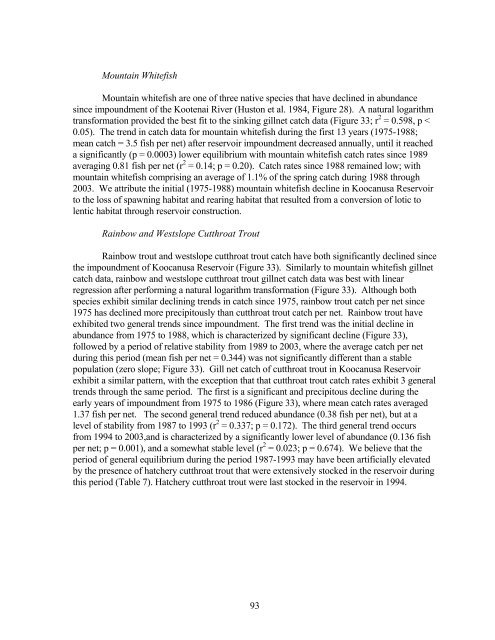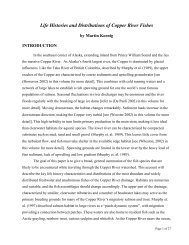Mitigation for the Construction and Operation of Libby Dam
Mitigation for the Construction and Operation of Libby Dam
Mitigation for the Construction and Operation of Libby Dam
Create successful ePaper yourself
Turn your PDF publications into a flip-book with our unique Google optimized e-Paper software.
Mountain Whitefish<br />
Mountain whitefish are one <strong>of</strong> three native species that have declined in abundance<br />
since impoundment <strong>of</strong> <strong>the</strong> Kootenai River (Huston et al. 1984, Figure 28). A natural logarithm<br />
trans<strong>for</strong>mation provided <strong>the</strong> best fit to <strong>the</strong> sinking gillnet catch data (Figure 33; r 2 = 0.598, p <<br />
0.05). The trend in catch data <strong>for</strong> mountain whitefish during <strong>the</strong> first 13 years (1975-1988;<br />
mean catch = 3.5 fish per net) after reservoir impoundment decreased annually, until it reached<br />
a significantly (p = 0.0003) lower equilibrium with mountain whitefish catch rates since 1989<br />
averaging 0.81 fish per net (r 2 = 0.14; p = 0.20). Catch rates since 1988 remained low; with<br />
mountain whitefish comprising an average <strong>of</strong> 1.1% <strong>of</strong> <strong>the</strong> spring catch during 1988 through<br />
2003. We attribute <strong>the</strong> initial (1975-1988) mountain whitefish decline in Koocanusa Reservoir<br />
to <strong>the</strong> loss <strong>of</strong> spawning habitat <strong>and</strong> rearing habitat that resulted from a conversion <strong>of</strong> lotic to<br />
lentic habitat through reservoir construction.<br />
Rainbow <strong>and</strong> Westslope Cutthroat Trout<br />
Rainbow trout <strong>and</strong> westslope cutthroat trout catch have both significantly declined since<br />
<strong>the</strong> impoundment <strong>of</strong> Koocanusa Reservoir (Figure 33). Similarly to mountain whitefish gillnet<br />
catch data, rainbow <strong>and</strong> westslope cutthroat trout gillnet catch data was best with linear<br />
regression after per<strong>for</strong>ming a natural logarithm trans<strong>for</strong>mation (Figure 33). Although both<br />
species exhibit similar declining trends in catch since 1975, rainbow trout catch per net since<br />
1975 has declined more precipitously than cutthroat trout catch per net. Rainbow trout have<br />
exhibited two general trends since impoundment. The first trend was <strong>the</strong> initial decline in<br />
abundance from 1975 to 1988, which is characterized by significant decline (Figure 33),<br />
followed by a period <strong>of</strong> relative stability from 1989 to 2003, where <strong>the</strong> average catch per net<br />
during this period (mean fish per net = 0.344) was not significantly different than a stable<br />
population (zero slope; Figure 33). Gill net catch <strong>of</strong> cutthroat trout in Koocanusa Reservoir<br />
exhibit a similar pattern, with <strong>the</strong> exception that that cutthroat trout catch rates exhibit 3 general<br />
trends through <strong>the</strong> same period. The first is a significant <strong>and</strong> precipitous decline during <strong>the</strong><br />
early years <strong>of</strong> impoundment from 1975 to 1986 (Figure 33), where mean catch rates averaged<br />
1.37 fish per net. The second general trend reduced abundance (0.38 fish per net), but at a<br />
level <strong>of</strong> stability from 1987 to 1993 (r 2 = 0.337; p = 0.172). The third general trend occurs<br />
from 1994 to 2003,<strong>and</strong> is characterized by a significantly lower level <strong>of</strong> abundance (0.136 fish<br />
per net; p = 0.001), <strong>and</strong> a somewhat stable level (r 2 = 0.023; p = 0.674). We believe that <strong>the</strong><br />
period <strong>of</strong> general equilibrium during <strong>the</strong> period 1987-1993 may have been artificially elevated<br />
by <strong>the</strong> presence <strong>of</strong> hatchery cutthroat trout that were extensively stocked in <strong>the</strong> reservoir during<br />
this period (Table 7). Hatchery cutthroat trout were last stocked in <strong>the</strong> reservoir in 1994.<br />
93
















